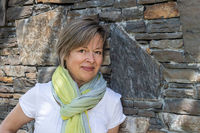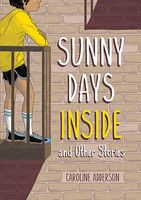Caroline Adderson's Smart New Story Collection Views the Pandemic from the Perspective of Kids Stuck at Home
Caroline Adderson is one of a few writers who is able to move seamlessly between writing acclaimed books for adults and writing beloved books for young readers, and her newest collection of short stories for middle grade readers is a fantastic addition to her stable of great reads.
Sunny Days Inside and Other Stories (Groundwood Books) is set during the pandemic (the "grownup virus") and explores quarantine and lockdown through the eyes of the children living in one particular apartment building.
Amidst strange new rules and restrictions, each kid reacts differently to the stress of pandemic life. From running laps on apartment balconies to starting up a business renting out the family dog, the stories weave together funny, heartfelt, and complex moments and emotions. And as the children in the stories react to the strain on their parents, grandparents, and older siblings, a valuable portrait emerges of not only the pandemic experience but how adult upheaval of any kind can impact kids.
We're excited to speak with Caroline today as part of our Kids Club series for writers for young readers. With more than half a dozen children's books and numerous awards under her belt, Caroline shares her insights about writing for kids, what she wishes more people knew about the process, and her favourite parts of the life cycle of a book. She tells us about why writing this book was "sanity-saving" and which of her seven protagonists she can relate to the most.
Open Book:
Tell us about your new book and how it came to be.
Caroline Adderson:
I’d always wanted to write a book of short stories for kids, but could never settle on a thematic link. Then COVID-19 began its rampage. I happen to live a block from an elementary school. At the start of the pandemic, when we were all shell-shocked and afraid, I took solace in watching the kids skip so happily past my window twice a day, as if the world wasn’t falling apart. I finally had my theme: the resilience of children in a global catastrophe.
OB:
What was the strangest or most memorable moment or experience during the writing process for you?
CA:
To be honest, the whole process was sanity-saving. I wrote this book differently than any I’ve written before. Normally, I rewrite continually through the first draft, every day polishing and revising what’s already on the page before moving forward. With this book I decided I would write a story a week for eight weeks – no going back! I just immersed myself completely in what was happening in that one particular apartment and moved on the next week. This exclusive focus meant, of course, that I was blessedly distracted from the actual horrors going on around me.
OB:
Is there a character in your book that you relate to? If so, in what ways are you similar to your character and in what ways are you different?
CA:
There are seven protagonists in Sunny Days Inside and Other Stories (the eighth story is about all of them). The characters most like me as a kid are Meena and Jessica in “The Two Harriets.” The two of them discover their mutual love of Harriet the Spy (my own favourite childhood book) and pass the lockdown phase of the pandemic by spying on the other tenants in their building. But I just love the twins in “How to Be a Cave Family” who see their hair growing out and the fruitless treks to the grocery store as a devolutionary process to be embraced. Entrepreneurial Louis cracks me up; he rents out his dog! Conner has the most to deal with, living with a laid-off dad partial to conspiracy theories. He diffuses an unhappy family situation and, in the process, atones for his own bad behaviour in the past. Perhaps all characters contain a little piece of their author, but I actually wish I was a bit more like them.
Your CanLit News
Subscribe to Open Book’s newsletter to get local book events, literary content, writing tips, and more in your inbox
OB:
What's your favourite part of the life cycle of a book? The inspiration, writing the first draft, revision, the editorial relationship, promotion and discussing the book, or something else altogether? What's the toughest part?
CA:
My favourite part is the visitation of the idea. It’s always so perfect! So intriguing! So regrettably fleeting! Because then the hard part comes: trying to translate the idea onto the page. With every word, the idea itself shape-shifts and becomes a different idea. First drafts are a torment for me. My second-favourite part is revising, especially when I get to work with as wonderful an editor as Shelly Tanaka at Groundwood Books. She helps me cut the non-essential from the story so that gradually, draft-by-pleasurable draft, the finished work shines forth.
OB:
Do you feel like there are any misconceptions about writing for young people? What do you wish people knew about what you do?
CA:
The major misconception is that it’s easier to write for kids than for adults. In fact, it’s harder. A children’s writer has many more considerations. You have remember how to think like a child. You have to consider the child’s reading level and maturity and whether your subject matter is appropriate to it. Will your story be acceptable to the adult gatekeepers (parents, librarian, teachers)? Writing for children looks “easy” because the books are shorter and simpler than books for adults. From my experience, as someone who writes for all ages, the shorter and simpler a story is, the more difficult it is to write.
_________________________________________________
Caroline Adderson is an award-winning author of books for young readers and adults. She is the author of the picture books Norman, Speak! (illustrated by Qin Leng) and I Love You One to Ten (illustrated by Christina Leist), as well as the Jasper John Dooley and Izzy series. Her middle-grade books include Middle of Nowhere, A Simple Case of Angels, and The Mostly True Story of Pudding Tat, Adventuring Cat. She has won the Sheila Egoff Award, the Chocolate Lily Book Award and the Diamond Willow Award, among many other honours.



